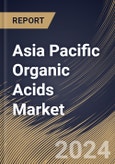Adopting these acids in animal husbandry is motivated by diminishing reliance on antibiotics in animal feed. They are incorporated into animal feed formulations to promote gut health, improve nutrient absorption, and mitigate the risk of diseases. As concerns about antibiotic resistance and livestock's overall health and well-being increase, the adoption of these acids in animal nutrition is expected to continue, supported by regulatory initiatives promoting responsible antibiotic use in agriculture.
They are used as pH adjusters in cosmetic formulations. Citric acid, for instance, helps maintain the pH of skincare and haircare products, ensuring their stability and effectiveness. Cosmetic products utilize organic acids possessing antimicrobial properties to inhibit the proliferation of bacteria and fungi, thereby prolonging the products' shelf life. Acids, such as acetic and citric acid, are employed as descaling agents in industrial and industrial cleaning applications to eliminate mineral deposits, including limescale. Some of the acids exhibit antimicrobial properties, making them suitable for disinfectants and sanitizing solutions.
The pharmaceutical industry in the Asia Pacific may work with organic acid providers to produce tailored solutions for specific drug formulations, boosting innovation and efficiency. The pharmaceutical industry's increasing focus on sustainability aligns with using these acids as alternatives to synthetic additives in the Asia Pacific. It derived from renewable sources contribute to sustainability efforts in the Asia Pacific region. The growth of the pharmaceutical industry in the Asia Pacific region can drive innovation in drug delivery systems, with organic acids playing a role in developing novel and efficient drug formulations. They are utilized to adjust the pH of drug formulations during manufacturing in the Asia Pacific. Hence, due to the above-mentioned factors, the market will grow significantly in this region.
The China market dominated the Asia Pacific Organic Acids Market by Country in 2022 and would continue to be a dominant market till 2030; thereby, achieving a market value of $3,710.2 million by 2030. The Japan market is registering a CAGR of 7.5% during (2023 - 2030). Additionally, The India market would showcase a CAGR of 8.3% during (2023 - 2030).
Based on Application, the market is segmented into Food & Beverages, Feed, Pharmaceuticals, and Industrial. Based on Type, the market is segmented into Acetic Acid, Citric Acid, Lactic Acid, Formic Acid, Propionic Acid, Ascorbic Acid, Gluconic Acid, Fumaric Acid, Malic Acid, and Others. Based on countries, the market is segmented into China, Japan, India, South Korea, Singapore, Malaysia, and Rest of Asia Pacific.
List of Key Companies Profiled
- Cargill, Incorporated
- BASF SE
- The Dow Chemical Company
- Archer Daniels Midland Company
- Eastman Chemical Company
- Tate & Lyle PLC
- DuPont de Nemours, Inc.
- Corbion N.V.
- Koninklijke DSM N.V.
- Celanese Corporation
Market Report Segmentation
By Application (Volume, Kilo Tonnes, USD Billion, 2019-2030)- Food & Beverages
- Feed
- Pharmaceuticals
- Industrial
- Acetic Acid
- Citric Acid
- Lactic Acid
- Formic Acid
- Propionic Acid
- Ascorbic Acid
- Gluconic Acid
- Fumaric Acid
- Malic Acid
- Others
- China
- Japan
- India
- South Korea
- Singapore
- Malaysia
- Rest of Asia Pacific
Table of Contents
Companies Mentioned
- Cargill, Incorporated
- BASF SE
- The Dow Chemical Company
- Archer Daniels Midland Company
- Eastman Chemical Company
- Tate & Lyle PLC
- DuPont de Nemours, Inc.
- Corbion N.V.
- Koninklijke DSM N.V.
- Celanese Corporation
Methodology

LOADING...








